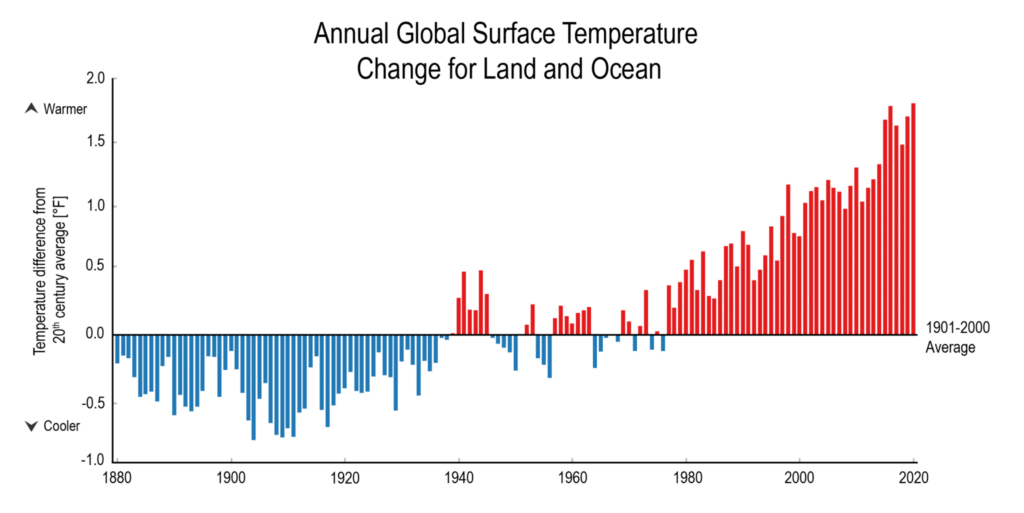Climate change is a very real threat, and it affects employees’ lives daily. As our climate changes, so does our physical and mental health. From air pollution that causes lung disease to natural disasters that cause post-traumatic stress disorder (and more), climate change directly impacts your employees—and not in a good way.
57% of employees say climate change is a source of anxiety, according to a recent Jellyvision survey. Yet only 35% of employers make combating climate change an important priority for their company. 23% percent say it is not a priority at all.
Those that are addressing the impact of climate change are taking small steps that can collectively have a big impact. For example, Jellyvision found that:
Facing the facts on climate change
Let’s face it. Climate change isn’t just a theory anymore. Consider rising global temperatures. Just how much have temperatures risen? Since 1896, average winter temperatures across the contiguous 48 states have increased by nearly 3°F, according to the United States Environmental Protection Agency (EPA). Spring temperatures have increased by about 2°F, while summer and fall temperatures have increased by 1.4°F.

How does all of this translate to our health? A new report from the medical journal The Lancet, for example, found that more than a third of heat-related deaths in the United States are caused by climate change.
What is worse? There are more and more days of heatwave exposure. Authors state that in 2020, adults over the age of 65 experienced a total of nearly 300 million more days of heatwave exposure in the U.S. compared to the 1986-2005 average baseline. This makes 2020 the second highest year of exposure recorded since 1986.
In addition, between 2030 and 2050, climate change is expected to cause approximately 250,000 additional deaths per year, according to the World Health Organization. How? From malnutrition, malaria, diarrhea, and heat stress.
Combating climate change isn’t something we can solve overnight, and it isn’t something one employer can tackle on their own. It’s going to take massive new legislation, government guidance, and global agreements to change how we operate. However, there are some steps employers can take to help employees navigate this new (and hotter) world in which we live.
Why is it important to help employees?
First, we are talking about your most valuable asset: your workforce. Without them, you do not have a business. Second, raising awareness of the impact of climate change on employee health—and your commitment to keep people healthy—can work wonders for employee satisfaction, engagement, and retention. Third, by keeping people healthy, you are striving to improve outcomes and reduce overall healthcare costs.
From enrollment to year-round benefits engagement, ALEX has your back.
How does climate change affect your employees’ health?
It is not a question of whether rising temperatures are affecting your employees’ health—it’s how. Here are just a few examples to think about:
- Allergies: As temperatures rise, plants produce more pollen for longer periods of time, lengthening the allergy season and worsening employees’ allergies.
- Heart and lung disease: As temperatures rise, air pollution worsens, leading to more frequent asthma attacks and other breathing problems.
- Dehydration and kidney problems: Hotter days make it more difficult to stay hydrated. Employees are also more susceptible to heat exhaustion, heat cramps, and heat stroke.
- Skin disease: Higher temperatures and the depletion of the ozone layer increase your employees’ risk of skin cancer.
- Digestive illnesses: Heat does not need to be extreme to take a toll on our health. Warmer water, for example, lets bacteria expand over time. These bacteria and harmful algae blooms that thrive in higher temperatures affect the food that we consume and can cause gastrointestinal problems.
- Infectious disease: As the planet warms, insect migration patterns change, allowing insects to spread farther and transmit diseases like malaria, dengue, Lyme disease, and West Nile virus more easily.
- Mental health conditions: Extreme heat can worsen certain mental illnesses. To complicate matters, some psychotropic medications interfere with the body’s ability to regulate temperature, making employees more vulnerable to heat.
- Neurologic disease: Extreme heat is linked with cerebrovascular disease, a disorder that affects blood supply to the brain.
- Trauma: Extreme heat is linked with aggression and violence.
Creating a plan to address the health effects of climate change
How does an employer start to move the needle on addressing health issues related to climate change? Consider the following four strategies:
1. Start with employee education.
Your employees may not even realize that rising global temperatures can have such a profound impact on their health. This means part of your strategy should involve raising that awareness through education. For example, plan a company conversation about climate change’s effect on employee health. Consider sharing interesting statistics and other data in advance to create a buzz around the topic.
For example, do employees know that:
- Every year, dozens of workers die and thousands more become ill while working in extreme heat or humid conditions?
- Heat waves may be amplified in cities, because they absorb more heat during the day than suburban and rural areas?
- 50% to 70% of outdoor heat-related fatalities occur in the first few days of working in warm or hot environments because the body has not had an opportunity to build a tolerance to the heat?
In case you’re looking for more resources, the Occupational Health and Safety Administration (OSHA) provides educational tools to help employers educate their workforce.
2. Meet with department managers.
The goal is to try and understand how climate change affects their team’s work. What resources and support do they need?
These conversations may vary depending on what type of organization you are. For example, managers at an agricultural company may be more concerned with heat exhaustion for farmers, while traditional corporate office managers might be more interested in cutting back on travel to reduce carbon emissions.
3. Conduct employee surveys.
What are employees’ attitudes toward climate change? What can they suggest in terms of how the company can respond? This could be an annual survey as well as various pulse surveys throughout the year to better gauge employee sentiment.
How to conduct a fool-proof employee engagement survey
4. Don’t just talk the talk.
Walk the walk as well. Once you know what employees need, respond. Let employees know what you are doing to make a difference in their daily lives. And hold yourself accountable when challenges arise. If a change is going to take time or additional resources, let employees know. Transparent communication is critical.
Specific strategies to help employees stay healthy despite rising temperatures
There are several ways in which employers can help employees stay healthy as the days get hotter. It’s all part of creating a proactive heat wave response plan to prevent heat illness at work:
Encourage preventative care. Many side effects of rising temperatures, like skin cancer, asthma, and heat stroke, are better treated if caught early. So remind employees to take advantage of their yearly check-ups, even if they’re not managing a known health condition.
Provide comprehensive mental health benefits. Research has shown that heat waves may be associated with higher drug and alcohol abuse, higher rates of depression, and more violent behavior and aggression. Employers that provide comprehensive mental health benefits can help employees deal with many of these unpleasant consequences.
Encourage employees to avoid going outside during the hottest times of the day. If employees work outside, OSHA says to follow the 20% rule, meaning on the first day of the heat wave, do not allow employees to work more than 20% of a shift at full intensity in the heat. Increase their time by no more than 20% each day until they are used to working in the heat.
Provide cool drinking water. Encourage employees to drink water even if they are not thirsty.
Provide sun-shielding clothing as well as sunscreen. Remind workers to also wear a hat and light-colored, loose-fitting and breathable clothing, if possible.
Encourage workers to monitor themselves and others for warning signs of heat illness such as heat stroke, heat exhaustion, heat cramps, sunburn, and heat rash. Create a procedure to follow when an employee suffers heat stroke (e.g., alert rescue, transport the employee in a cool and well-ventilated place, and undress or loosen his clothes).
Use energy-efficient cooling technology. This includes air conditioning, heat pumps, cool roofs, and more. There may even be tax incentives or rebates for some of these initiatives. Using energy-efficient technology can lessen the contribution to air pollution.
Have a plan for brownouts due to heat waves. How will you keep employees safe? Will you evacuate employees? If not, how will you provide them with useful means of protection such as auxiliary fans, mineral water misters, or external blinds? Will you provide coolers and ice packs for employee medications that require refrigeration? What about adapting work schedules.
Climate change is not going away anytime soon, and employers that come to terms with what’s happening and take proactive steps to keep employees safe and healthy will be glad they did. It is about taking relatively simple steps. Employees will thank you for making their health a priority.


